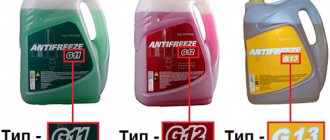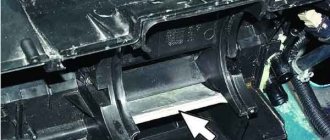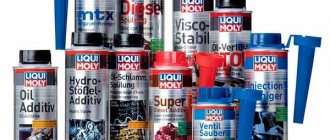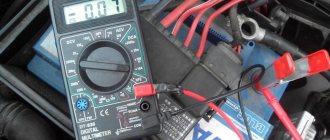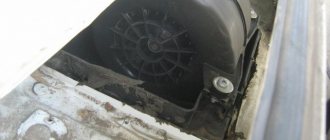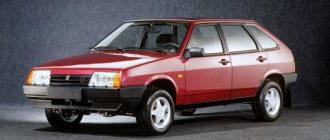Every car owner has at least once had the question of what would happen if you mixed several coolants of different brands. And also is it possible to mix antifreezes of different colors, how blue differs from red and similar thoughts. We will consider these and other questions below so that the reader does not use chemicals in the garage and damage his car.
It is worth noting that, subject to certain conditions, some antifreezes can be mixed. If you do not comply with them, you are guaranteed to “kill” the radiator in two to three years. And it will not be possible to restore it. Therefore, you should think carefully before exposing your car to such a risk.
Differences between antifreeze and antifreeze.
Today, three types of coolants for internal combustion engines are used: water (distilled or pure rainwater), antifreeze and antifreeze.
Antifreeze is the name of the liquid (translated as “anti-freeze”) for the engine cooling system, which does not freeze and can withstand high temperatures.
Standard composition of antifreeze for cars:
- Water.
- Ethylene glycol.
- Glycerol.
- Alcohol.
- Acid salts or carbonate additives.
Composition of antifreeze:
- Water.
- Anti-corrosion additives.
- Burates and phosphates.
- Alcohols.
- Glycols.
- Nitrites.
- Silicates.
- Nitrates.
Differences:
- antifreeze was invented later than antifreeze;
- Antifreeze is better in terms of environmental friendliness;
- The boiling point of antifreeze is higher;
- The freezing point of antifreeze is lower;
- Antifreeze provides better protection against corrosion.
- Antifreeze forms a protective film, but antifreeze does not, and therefore antifreeze cools much more efficiently.
- The service life for which antifreeze is designed is 6 times less than that of antifreeze.
- antifreeze protects engine cylinder liners from cavitation (air bubbles).
- The service life of the pump (pump) is significantly reduced if antifreeze is used.
- antifreeze does not clog radiators, and various types of deposits do not form.
The main disadvantage of antifreeze is that when heated to 105 degrees, its properties deteriorate.
Antifreeze boils when heated to 115 degrees and does not leave sediment in the channels and can be used for up to 250,000 km.
Differences between antifreeze and antifreeze
Antifreeze is antifreeze, but antifreeze may not necessarily be antifreeze - this definition contains the meaning of the similarities and differences between coolants. Antifreeze is the general name for coolants used in internal combustion engines. Such liquids may have different compositions and characteristics. Antifreeze is only one brand of non-freezing liquids, which originates in the 60s - 70s of the last century in the former great power - the Union of Soviet Socialist Republics (USSR)
If you mix antifreeze with antifreeze, the most unpredictable consequences are possible, so it is important to always know the brand of coolant that is poured into the engine. If it is antifreeze, then you should also only add coolant of this type, or you must be sure that the added liquid is completely identical in composition to the material in the engine.
Differences in composition
The standard composition of antifreeze is water, ethylene glycol and additives that have an anti-corrosion and anti-foaming effect. Over more than half a century of history, this type of coolant has remained virtually unchanged in the ratio of basic substances. The approximate composition of the “classic” composition is as follows:
- Water – 30%.
- Ethylene glycol – 60%.
- Additives – 10%.
Depending on the concentration of the main substance (ethylene glycol), the freezing point of antifreeze changes, so it is not difficult for manufacturers to set up production for regions with winters of varying severity.
Antifreezes of other brands are also most often made on the basis of ethylene glycol, but foreign-made fluids may use higher quality additives that can more effectively protect internal engine elements from corrosion.
By characteristics
Among the main characteristics of domestic antifreeze, the following properties should be noted:
- Does not freeze to a temperature of minus 65 degrees Celsius (red antifreeze).
- Does not boil before a certain heating point.
- Has low viscosity.
- It has high heat capacity and thermal conductivity.
- Possesses chemical stability over a wide temperature range.
- Does not foam and does not cause corrosive destruction of metals.
Antifreeze of other brands may differ in the presence of more effective additives that make it possible to better combat undesirable manifestations during operation. For example, in coolants in which the main quality-improving component is carbosilicates, the protection of metal elements washed by anti-freeze is better implemented. The use of antifreeze of this type allows you to almost completely get rid of deposits inside the cylinder jacket channels, as well as in radiators and pumps. The absence of mechanical contamination allows you to significantly extend the service life of these parts.
Hybrid brands of antifreeze are more modern liquids used to cool internal combustion engines. Such mixtures can withstand long-term temperature loads without compromising quality.
New propylene glycol-based antifreezes have virtually no disadvantages. A distinctive characteristic of such substances is the absence of toxic effects on living organisms, a high level of protection of metal engine parts from oxidation and the prevention of foaming. The disadvantage of propylene glycol-based antifreezes is their high cost, which imposes certain restrictions on their widespread use in our country.
What happens if you mix antifreeze with antifreeze?
Firstly, the question is why mix these two different refrigerants. Well, various circumstances happen on the road, for example, there is an antifreeze leak and after eliminating the leak, you need to add antifreeze. But there is not always a canister of antifreeze in the trunk, and here they sell antifreeze nearby on the side of the road. You have to buy it and top it up to continue moving forward.
Or, as often happens, sooner or later after buying a used car, you have to top up the coolant, and then the driver asks the question: what was filled in before? Color is easy to determine, but classes are difficult. In such cases, experts recommend, again, not to save, but to drain the old fluid and fill in the new one in full. It is even possible that the old one has expired.
But, let's look at what happens after adding antifreeze to antifreeze.
From the composition we know that they only have in common water and, perhaps, a standard (ethyl alcohol). And each manufacturer adds different additives and additives in different quantities. Therefore, when mixing antifreeze and antifreeze, a sediment may form that will settle in the channels and on engine parts, which will gradually reduce the life of the internal combustion engine. Nothing bad will happen when adding antifreeze to antifreeze if their components are basically the same, but this cannot be checked with your own hands without a chemical laboratory.
Based on the above, we conclude that if you already had to mix antifreeze and antifreeze, then upon arrival, it is better to drain this liquid, do a complete flush of the engine cooling system and fill in a new homogeneous mixture. The cost of buying new antifreeze will save you a lot of money, effort and time.
Liquid cooling system
Liquid or water engine cooling systems are incredibly popular and common among automakers. Initially, ordinary water was used for such purposes. The advantage was that it was easy to get even in extreme situations.
However, water as a coolant has its disadvantages:
- corrosion begins quickly;
- when using dirty water, it is necessary to flush the system;
- low freezing temperature;
- rapid boiling;
- active evaporation;
- frequent engine failure;
- the need for constant monitoring of the cooling system;
- a large amount of sediment when using untreated water, etc.
Manufacturers realized that you can’t go far on water. First, glycerin and alcohol were added to the water. The composition has improved and modernized. As a result, we received special coolant, which is called antifreeze. The concept of antifreeze is also actively used in the post-Soviet space.
Let's look a little at the classification so that you can further understand whether motorists can mix compounds in certain situations. Namely:
- different brands;
- different manufacturers;
- different colors, etc.
Some are sure that antifreeze and antifreeze should never be mixed. Others believe that even if you mix red with green, red with blue, or yellow with any other colors of coolant, absolutely nothing terrible will happen. So we will find out who is right.
Is it possible to mix different brands of antifreeze?
Let's start with what classes of antifreeze there are. This:
Antifreeze G11 is a liquid of inorganic origin and contains silicates. Available in blue or green colors. Suitable for old cars.
Antifreeze G12 is a liquid of organic origin. Produced in pink and red flowers.
Antifreeze g11 and g12 what is the difference
The difference between antifreeze g11 and g12 is that inorganic G11 contains substances that protect against corrosion (inhibitors). Thanks to corrosion inhibitors, a film is created on parts and protects it from contact with oxygen, which causes the metal to rust. Antifreeze GI 11 is glycol-based, that is, if you do not add corrosion inhibitors, the aggressive glycol will begin to corrode metal parts. OX G11 must be changed at least once every 2-3 years. The common color of JI-11 is green. Green G11 is the lowest class.
As for G12 class antifreezes, they are based on carbosilicates. Since many parts in an internal combustion engine are made of aluminum and steel, upon contact with liquids, destructive films are formed on their surfaces. The additives contained in GI 12 prevent the formation of a destructive film (the technology is called Long life). The substances in G12 do not form a protective film on all surfaces of channels and parts, but only where pockets of corrosion have appeared, in order to protect against further destruction of the metal. This class of antifreeze begins to boil at a temperature of 120 degrees. Service life 5 years.
A little classification
Currently, 6 compositions are used for automobile engines, or more precisely for their cooling systems:
They can be from different companies, the same color, different shapes, types, etc. That is, color is not a fundamental criterion here. Therefore, one type of composition can be blue and green, yellow and red, etc.
Let me tell you about each composition separately.
- Antifreeze. An old type of antifreeze, developed during the USSR specifically for Soviet cars as a response to imported antifreeze. Consists of a regular aqueous solution using complex alcohols. This includes ethylene glycol and special protective additives;
- G11. Traditional coolant based on ethylene glycol, water and additives. Silicates, phosphates, as well as borates, nitrites, etc. are used as additives. They do not have long service life. Main color is blue;
- G12. Carboxylate automobile antifreezes, to which, in addition to the components from G11, carboxylates are added. These are compounds of a fairly effective carboxylic acid. The coolant lasts a long time, the composition is mainly painted red or pink;
- G12+. A hybrid fluid based on water, as well as ethylene glycol, carboxylate, silicate, nitrite and phosphate additives. The composition of the coolant may vary depending on the manufacturer and its geographical location. Mostly red;
- G12++. So-called hybrid liquids. An organic base and silicates are used. In many ways similar to G12+ antifreeze, but has a longer service life;
- G13. A new type of coolant, where ethylene glycol was abandoned and replaced with propylene glycol. This component is harmless, which is why it quickly gained popularity. It comes in pink and purple most often.
But you must understand that any of the antifreeze presented can be painted in completely different colors. This has nothing to do with the composition. Color is a purely decorative component.
Initially, manufacturers wanted to stand out by changing the color of the standard white liquid. But gradually everyone began to use different coloring options. Dyes are used for this.
Is it possible to mix antifreeze with water?
Since antifreeze contains a significant amount of water, if you add water to antifreeze, nothing bad will happen. Dilution simply occurs and concentration decreases. The more water you add, the worse the antifreeze properties will become.
But sometimes it is recommended to add water to antifreeze. This approach is used when antifreeze has boiled, causing water to evaporate and the remaining liquid in the cooling system to become highly concentrated. But when adding, you need to know the proportions. Excessive amounts of water will cause rust to appear in the cooling system.
Attention: mixing water with antifreeze is only possible in summer. At sub-zero temperatures, such diluted coolant can quickly seize and freeze.
If such antifreeze freezes, you will have to invest in repairs in the car components. Usually, when the coolant freezes, the radiator of the stove and engine ruptures, as well as pipes burst and hoses crack.
Even if the antifreeze was boiling and it became highly concentrated, it is better to add antifreeze of the same class and brand. In winter, it is safer to operate the car with high concentration antifreeze.
The conclusion about adding water to antifreeze is this: if you had to add water, then add a little.
When adding antifreeze, add only antifreeze of the same class that was added previously (G11, G12, G12+, G13) and the same color. Antifreeze class G-13 is based on propylene glycol.
Is it possible to mix antifreeze of different brands?
Coolant of different brands can be mixed, provided that they have a similar composition and are also included in the same group. If you are not sure that the parameters of the added and used antifreeze are similar, then you should not put the cooling system at risk.
By mixing liquids of different compositions, you can get a negative reaction. Namely:
- Deposits may appear in the cooling system, leading to the formation of a mixture with even lower performance properties. Additives in different brands of antifreeze may react. The consistency of the coolant may change, for example, thicken, which will lead to a deterioration in its circulation through the system. This leads to clogged pipes and overheating of the motor lubricant and the engine itself. To fix this problem, you will need to completely drain the liquid, replace the pipes, flush the system and fill it with fresh antifreeze.
- Substances from different brands of antifreeze, when mixed, can neutralize each other's work. If a situation arises where you still have to mix them, you will definitely need to drain the mixture, rinse the pipes and radiator. Then add fresh antifreeze.
- When mixing coolants of different compositions, the likelihood of antifreeze foaming increases. Foam accumulates in the expansion tank and system pipes. The situation cannot be corrected by adding anti-foam additives. The intervention of car service specialists will be required to flush the system, after which you need to fill in fresh coolant.
Excessive clogging of the cooling system pipes leads to the following consequences:
- bearings wear out quickly;
- the pump overheats and fails;
- overheating of the cylinder head and other engine components, which leads to its deformation and destruction.
That is, the consequences of mixing can be extremely serious, therefore, you should not expose your car to such a risk. And if such a need arises, the composition of the coolant should be taken into account.
Antifreeze and water can be mixed
Antifreeze contains the same elements: water and ethylene glycol. Antifreeze was invented in the USSR in 1971.
Classification of antifreeze by type:
- A - ready to be poured into the car’s cooling system.
- M - modernized, that is, it contains additional components.
- K is a highly concentrated liquid, it will have to be diluted.
After the letters, which are divided by type, write 2 numbers - subzero temperature, at which the antifreeze will not freeze. For example, M40, or M65.
The color of good antifreeze is between blue and light blue; there is also a greenish color. Antifreeze brand A65 is red. Legal in Russia, GOST 28084-89 distributes three types of OZh-K, OZh-40, OZh-65. If there are no coolant (coolant) designations, there is only a GOST number, then it is a fake.
Is it possible to mix yellow, red and green antifreeze?
As I already noted, violet and yellow refrigerants, for the most part, are G13 class compounds. The basis of such compositions is propylene glycol. The situation is completely different with green and red antifreezes. Here, manufacturers use ethylene glycol. In each case we are talking about alcohol, but still, the liquids are different, which means it is not recommended to mix them.
Another argument in favor of not mixing formulations is the added additives. For green and red refrigerants, their own additives are selected, and for violet and yellow ones, their own. The consequences of the interaction of substances are not entirely predictable, therefore, it is not worth the risk. One of the possible troubles may be sedimentation in the system. This means that in the future you will have to clean and flush the pipes and radiator.
In addition to possible troubles associated with mixing unsuitable antifreezes, difficulties may arise when using counterfeit compounds. In this regard, it is necessary to pay attention to the quality of the antifreeze purchased.
Consequences of mixing antifreeze and antifreeze.
If antifreeze and antifreeze are successfully mixed, that is, when you are lucky, the main components of the composition of both liquids are the same, then there will be no formation of sediment and clogging of channels. But, it is very difficult to know the composition of both liquids.
If the bases of these liquids are different, then when adding antifreeze to antifreeze or antifreeze to antifreeze, the liquid may immediately become cloudy and with sediment, or this will happen after natural heating of the engine or using engine preheating.
What happens next if you mix antifreeze and antifreeze?
The resulting sediment, flakes, jelly at the bottom - all this will lead to a stop in circulation and overheating of the engine. And overheating the engine is expensive. Also, due to precipitation in the coolant, the pump, radiator and pipes may become clogged, and this leads to a more complex repair than, for example, replacing the washer fuse (a difficulty for many is how to find the washer fuse).
A stop in circulation can also occur when pouring only antifreeze, but a counterfeit one that coagulates when heated.
Mix antifreeze of different colors
If you need to mix antifreeze with antifreeze of different colors, then in this case you should accurately determine the composition of the liquids. If the same set of substances is used, then it is possible to use simultaneously compositions that are identical in color, as well as ones that differ significantly in this parameter. Antifreeze is most often made in blue color (at a freezing temperature of up to -40˚C), but it can also be mixed with purple compounds, which, as a rule, belong to the G13 category.
Differences between red and green antifreeze
Antifreeze can be produced not only in green, but also in red. The only difference is the freezing temperature. In red antifreeze, the concentration of ethylene glycol is higher, so the liquid state of antifreeze is maintained down to a temperature of -65˚C. Blue or green antifreeze liquid is designed for operation down to temperatures of -40˚C.
In most of our country there is no need to use antifreeze with a maximum freezing point. If, when operating a car in central Russia, a significant amount of water was added to the working fluid instead of antifreeze, then before the winter season you should add red antifreeze and measure the density of the liquid. If the concentration of ethylene glycol is too low, the antifreeze should be completely replaced.
Is it possible to mix antifreeze of different colors?
You can mix antifreeze of different colors only if the liquid is manufactured by the same company. If in the Soviet Union there was a GOST for the production of anti-freeze, then in modern Russia each manufacturer decides for himself what the composition of the coolant sold in one color or another will be.
We should also not forget about the presence of a significant number of counterfeits on the domestic market. That is, even if there is a label from the same company, there is no guarantee that the fluids are the same and that the original product is used, which was previously poured into the engine. For this reason, you should mix antifreezes of different colors only if absolutely necessary.
Consequences
The consequences when mixing coolants are the same as when using unsuitable antifreezes according to the “G” classification. The following undesirable changes may occur in the engine:
- Sedimentation.
- Neutralization of additives.
It is also possible that the aggressive qualities of the liquid will increase, which will lead to corrosion of metal parts of the cooling system.
Properties and composition of antifreeze
People who have been interested in this topic for several days have probably looked at the label with the composition of one or another type of coolant. Among the many chemical elements in the comprehensive list of active substances, one can single out a certain base around which the entire process and the entire functionality of antifreeze is built. As some may have noticed, this base is most often ethylene glycol , as well as copious amounts of distilled water. Depending on the type, manufacturer and color of antifreeze, the proportion of this substance is approximately 75% of the total composition of the liquid.
This statement means that almost all types of antifreeze are 70-80% compatible in composition. However, is this a sufficient indicator for mixing different antifreezes? It is the additives that determine the functionality of the liquid and distinguish them from each other and perform a protective function in antifreeze, preventing the active elements from destroying the engine walls from the inside.
Depending on the functions of antifreeze, it is given a different composition of additives, which provide the desired effect of use. Protective additives, forming a film on the surfaces of the pipes, do not allow them to actively interact with destructive molecules of the substance (these include G11 and TL). On the contrary, anti-corrosion ones do not form a film, but they do an excellent job of removing carbon deposits and rust while driving. These include all variations of G12 and G11 antifreeze.
Differences between additives
Additives, in turn, are divided into protective, anti-corrosion and hybrid, these are not the same thing:
- Protective - as it becomes clear, they protect by simply forming a film inside pipes, hoses, radiators and other things. It should be noted that they are based on chemical elements. Characteristic of G11
- Anti-corrosion - these compounds already fight pockets of corrosion inside, there is no film here, they simply block pockets of rust and other deposits. It should be noted that they are based on organic substances. Characteristic of G12
- Hybrid - here, as you already guessed, two types are used at once, protection + “anti-corrosion”; mainly such additives are used in G13
What about antifreeze? They use exactly the same additives as, say, G11 antifreeze; in general, they are very similar to it.
What does the color of antifreeze mean?
I think we have sorted out the additives and types of antifreeze. But what about the different colors of antifreeze? Do they affect anything? In this case, a reservation should be made. Several years ago, very strict accounting was introduced, when different types of antifreeze were added their own color in a strict order. Manufacturers kept records of all types of coolants produced and assigned them the required shade.
Confusion arose with the emergence of more and more manufacturers who did not take into account the existing rules established by such large players as Volkswagen, Mercedes, Volvo and so on. The abundance of green antifreezes brought confusion to the existing system, and therefore focusing on color as a specific type has not worked for a long time. And the color itself became a necessary convention. However, if you come across old samples of antifreeze, you can determine the desired antifreeze by color. G11 is green, G12 is red, G13 is brown or purple. But you can’t trust colors alone - consider the composition and active elements.
Is it possible to mix different brands of antifreeze, for example G11 and G12?
Despite the presence of opponents of this method, and people who do such manipulations without hesitation, a clear opinion has formed on the network, which has a detailed definition of the consequences of mixing different brands with each other.
According to these data, mixing G11 with any other analogues (including G11 itself) is acceptable, except for G12. It (G12) can only be mixed with similar and G12+. Antifreeze types G12+, G12++ and G13 are fully compatible with each other and with G11.
Mixing issue
If you think that it is completely safe to mix red with red, but blue and green car antifreeze should under no circumstances be combined with each other, do not rush to conclusions.
First of all, I advise you to read the material on choosing the best antifreeze. Here is a link to this article. It is recommended for all cars to choose only the highest quality compounds. Moreover, it is not so important whether we are talking about antifreeze, or whether it is motor oil, a flushing agent or some kind of rust converter. We put quality first. And it will be better if you constantly start using the same antifreeze.
It is better to mix compounds in winter and summer in emergency situations, when there is simply no way to find the original coolant. If you buy a concentrate, then you simply have to mix it with water. But not from the tap, but with special, purified and distilled water.
As you understand, coolants differ in composition and additives used. And many of them can coexist in the same liquid without causing sediment or forming a gel from antifreeze.
If you mix coolants that differ in manufacturer and color, no disaster will definitely happen. But you shouldn’t experiment without urgent need. In the worst case scenario, the resulting mix will not last as long as you originally expected.
Motorists are interested in the possibility of mixing:
- compositions of the same color;
- mixtures from different companies;
- G11 and G12;
- G12 and G12+;
- G12 and G13;
- Coolant from different companies (for example, Sintek and Felix)
- antifreeze and antifreeze;
- G11 and G12++;
- G12++ and G13;
- red and blue;
- blue and green;
- pink and purple.
The list goes on and on as there are so many potential combinations.
But you should rely on generally accepted rules. They will be the basis for making decisions regarding mixing different coolants in emergency situations.
These rules read as follows:
- do not mix coolants that belong to classes 11 and 12;
- it is allowed to combine G11 with G12+ and even with G13;
- if necessary, you can combine 12 and 12+;
- in the case of a combination of 12 with 12++ or 13, it is better to refuse such a mixture;
- It is not forbidden to combine 12, 12++ and 13 in parallel.
Agree that it is quite difficult to keep such formulas in mind. But sometimes it is better to have the appropriate knowledge in order to avoid mistakes.
Coolant and its composition
What is antifreeze
Antifreeze is a special coolant designed to prevent the risk of engine overheating. With its help, the proper temperature is maintained and heat is removed.
According to technological requirements, the operating temperature must be kept within certain limits. When it is exceeded, various breakdowns occur, including irreversible ones.
You also need to oh, “antifreeze” and “coolant” are equivalent concepts. Motorists use in their everyday life the terms to which they are accustomed.
Compatibility of Antifreeze G11 G12 and G13 - can they be mixed
The basis of any cooling composition is a glycol base (propylene glycol or ethylene glycol), its mass fraction is on average 90%. 3-5% of the total volume of concentrated liquid is occupied by distilled water, 5-7% by special additives.
Each country that produces cooling system fluids has its own classification, but to avoid confusion, the following classifications are generally used:
- G11, G12, G13;
- by color (green, blue, yellow, purple, red).
Reference. Classification by color does not guarantee the identity of the composition and the possibility of mixing, since there are no generally accepted world standards for colors, and the manufacturer has the right to paint antifreeze in any color.
Groups G11, G12 and G13
The most common classification of cooling compounds is the classification developed by VAG.
Composition gradation developed by Volkswagen:
G11 - coolants created using traditional, but currently outdated, technology. Anti-corrosion additives include a variety of inorganic compounds in different combinations (silicates, nitrates, borates, phosphates, nitrites, amines).
Silicate additives form a special protective layer on the inner surface of the cooling system, comparable in thickness to scale on a kettle. The thickness of the layer reduces heat transfer, reducing the cooling effect.
Under the constant influence of significant changes in temperature, vibration and time, the additive layer is destroyed and begins to crumble, leading to a deterioration in the circulation of the coolant and causing other damage. To avoid harmful effects, silicate antifreeze should be changed at least every 2 years.
G12 is an antifreeze that contains organic additives (carboxylic acids). A feature of carboxylate additives is that a protective layer does not form on the surfaces of the system, and the additives form a thin protective layer less than a micron thick only in places of damage, including corrosion.
- high degree of heat transfer;
- the absence of a layer on the inner surface, which eliminates clogging and other destruction of various components and parts of the car;
- extended service life (3-5 years), and up to 5 years you can use such a liquid if you completely clean the system before filling it and use a ready-made antifreeze solution.
The main, but significant disadvantage of the carboxylate mixture is that the additives included in its composition begin their work only when corrosion processes appear, but do not have preventive qualities.
To eliminate this disadvantage, a hybrid antifreeze G12+ was created, which combines the positive characteristics of silicate and carboxylate mixtures through the use of organic and inorganic additives.
Is it possible to mix
Components
In this case, it is necessary to take into account the composition of the liquid. It includes several substances:
- ethylene glycol – dihydric alcohol;
- antifoam additives;
- lubricants;
- anti-corrosion additives.
Alcohol acts as the basis of the coolant. It ensures proper heat transfer and does not freeze at low temperatures, which is very important for the safety of the entire cooling system.
Accordingly, it is necessary, recalling school physics and chemistry lessons, to remember how different liquids mix with each other.
How to check antifreeze compatibility
It is easy to find out the compatibility of various coolants even at home or in the garage. True, this method will not give one hundred percent confidence that after mixing two antifreezes, the composition will work normally and perform its functions in the car.
The method is as follows. It is necessary to take a sample of the liquid that is poured into the cooling system and mixed in a separate container with the one that is planned to be added. You can take a sample using a syringe from the expansion tank or use the drain hole.
After receiving a sample of antifreeze from the car, pour it into any, preferably transparent, container and add to it approximately the same amount of coolant that you want to add to the cooling system. Leave the mixture for 5 – 10 minutes.
If mixing did not lead to a violent reaction in the container, foam did not appear on the surface of the composition, or sediment fell to the bottom of the container, then most likely the antifreezes are compatible with each other. If at least one of the listed reactions is detected, it is strongly recommended to avoid mixing such antifreezes. To make the test more accurate, mixed liquids can be heated to 80 - 90 °C.
Mixing
What to do if you have to mix
However, it should be noted that there are quite a lot of situations when you have to mix different types of antifreeze. Any car store offers a variety of products from different manufacturers, so making a choice becomes very difficult.
Sometimes you can successfully hit it “at random” and choose types of liquids that interact well with each other. But sometimes it happens that they lie in layers and in this state disrupt the operation of the cooling system.
The main element is ethylene glycol. The alcohol base of all coolants allows us to hope that mixing will occur normally. However, the whole thing is spoiled by numerous chemical additives designed to improve physical and chemical properties.
Fake antifreeze
Actually, it seems to me that the topic is completely covered! BUT what I would like to say finally is - have you ever wondered why some formulations, say branded or serious companies, are expensive, but there are formulations that are very cheap?
The same G13 antifreeze, made under the patronage of Volkswagen (usually purple), can cost 300 rubles per liter
And the yellow one, let’s say the same G13, produced somewhere unknown and not clear by whom, can cost the same money only for a 5 liter canister.
The whole point here is “fake”, because a high-quality liquid will not be cheap, and it will also meet all the characteristics and safety requirements, such as:
- Will boil over 100 degrees (usually 105 to 110 degrees)
- When boiling, will not ignite
- Will not lose characteristics
When you buy cheap antifreeze, you simply cannot test it, but it’s not uncommon for it to boil well below 100 degrees! Because of this, your engine can simply overheat and fail.
And when mixing cheap and expensive options, always think, HAVE YOU CHECKED THE QUALITY OF THE INEXPENSIVE PRODUCT? Does it meet the standards? Otherwise, you will simply ruin the branded expensive and high-quality liquid!
Therefore, most antifreezes can be mixed, but everything must be done wisely!
Now this is a useful video, I recommend it to everyone.
I’ll finish this, read our AUTOBLOG.
( 32 votes, average: 4.56 out of 5)
Adviсe
Tips for choosing antifreeze
- Try to choose the same antifreeze.
- Pay attention to the class, composition and recommendations of the manufacturers.
- If you cannot find the same antifreeze, try to choose one that is as close in type as possible.
- If you don’t know what kind of antifreeze you will be mixing with, choose a new liquid that is as universal as possible - with a minimum amount of chemical additives and additives.
By following these recommendations, you can hope that mixing different antifreezes will be “painless,” and the cooling system will quietly switch to the new liquid.
Immediately after adding new antifreeze, you should carefully monitor the condition of the car engine.
If any problems are observed - unstable operation, “sneezing”, increased temperature, it is better to completely change the coolant and check the entire system.
Drawing conclusions
Practice clearly proves that drivers can mix coolant from different brands and manufacturers in the tank, even if they have the same class and chemical composition. In such situations, it is unlikely that sediment that is dangerous for the cooling system of a car engine will form.
Here it is recommended to navigate not by color, but only by the direct chemical composition. Color is created by dyes, and therefore has no real meaning. That is, compositions that have exactly the same components, identical from a chemical point of view, can easily have completely different colors. Therefore, a combination of any colors of antifreeze is allowed, provided that their composition is the same.
Only here you should be careful. There are a large number of fake coolants on the market. No one can say for sure what their composition is. Therefore, when combining counterfeits, it is impossible to guarantee the normal operation of the system.
Let's hope I was able to answer all your questions. If not, write in the comments.
Thank you for your attention! Subscribe, ask questions and invite your friends to join us!
( 3 ratings, average: 5.00 out of 5)
Did you like the article?
Subscribe to updates and receive articles by email!
We guarantee: no spam, only new articles once a week!
There was a small leak from the expansion tank, now you need to add about 1 liter of antifreeze so that it is right in the middle between the min marks. and max. But I don’t know what’s in the tank... and I don’t want to change all the fluid.
Is it possible to add water to antifreeze?
There are various situations in life when the required amount of refrigerant is not at hand. Therefore, in order to get to the nearest service station or auto shop, you have to fill up with ordinary water.
To avoid serious problems with your car in the future, you need to adhere to the following recommendations:
It is advisable to use ordinary tap water only when boiled. Carrying out such a simple heat treatment will remove a significant part of harmful impurities from the water. For minor additions, it is advisable to adhere to the recommended proportions to maintain the functionality of the remaining antifreeze.
This is very important in winter, if the air temperature outside is negative. In summer, you can drive with diluted refrigerant for a longer period of time. Before the first frost sets in, you need to drain all the liquid from the system and clean it completely.
After completing this work, you must fill in new refrigerant.
What happens if you dilute it with water?
Perhaps every car owner has thought about using water instead of a special coolant. But this is not the best idea, since it has the property of crystallizing already at zero, and boiling away when the temperature reaches 100 degrees. And the engine must operate both in frost and at the highest temperatures, which very often exceed a hundred. And here the next logical question arises - is it possible to dilute antifreeze with water?
In fact, it already contains distilled water, and its content is about 70% of the total antifreeze composition.
Therefore, diluting antifreeze with water is quite acceptable and this will not cause any special changes. The most important thing is to first determine the measure, because you can’t go too far in this matter either.
A clogged pipe is a consequence of mixing coolant with ordinary water (not distillate)
You can dilute antifreeze with water in the summer when it is very hot. At this temperature, the liquid warms up all the time and the water from its composition evaporates, as a result of which the additives are consumed faster. And this is exactly the case when adding water is quite acceptable.
In addition, sometimes the cooling system hoses become damaged and fluid leaks out. Here you shouldn’t even think about whether it’s possible to mix antifreeze with water, because in most cases, car owners do just that. But this, again, is in the summer. Is it possible to mix antifreeze with water in winter? This is where it is not recommended to dilute the coolant, because an increase in water content causes the liquid to freeze even before the temperature drops to -10, since water has the ability to quickly crystallize.
Rust - consequences of using water instead of coolant
If you are faced with the question of how to dilute antifreeze concentrate, then here you also need to know a few tricks. To know how to dilute antifreeze concentrate, carefully read the information on the packaging and make sure that the proportions are correct. In order to calculate them, you need to determine the balance at which it will be safe to mix the concentrate - something between the boiling point and the freezing point. Ideally, this is a 1:1 ratio, with one liter of coolant per liter of water. However, the correct formula does not guarantee that the water will not freeze at the most inopportune moment.
Thus, before diluting antifreeze with water or coolant of a different brand/color, you should take into account all its functional characteristics - only then can you be sure that you will not damage the inside of the car.
A little history
In order to understand in which cases antifreeze and antifreeze can be mixed and in which not, it is worth knowing about the history of coolants. At the dawn of the development of the automotive industry, plain water was poured into engines, many of whose parts were made of cast iron. In winter, ethylene glycol was added to it in order to prevent freezing. With the invention of more complex engine designs, manufacturers had to develop more advanced coolant formulations. The fact is that water with ethylene glycol literally corroded new steel engine components, provoking corrosion processes.
What makes motorists dilute antifreeze?
As you know, antifreeze (coolant) regulates the temperature conditions of a running engine. In summer, the composition does not allow the power unit to overheat, and in winter it does not freeze. The technical composition of the developments is represented by a combination of two main substances:
- water distillate (35%);
- ethylene glycol (63%).
To prevent corrosion processes and extraneous chemical reactions when air masses enter, the manufacturer enriches antifreeze with various additives (2%).
Manufacturers do not recommend
Depending on the manufacturer, these ratios may be different, but the mixture is always characterized by clear proportions. Therefore, before pouring anything into antifreeze, you need to read the instructions. Each brand of coolant has a set viscosity value at which the composition is effective. Viscosity affects the freezing or evaporation point in hot weather.
Not a single manufacturer recommends adding water to antifreeze. Unless, of course, it is a factory concentrate originally intended for dilution. When the car owner uses a fully prepared composition, experiments are extremely undesirable. Technical fluid is a collection of chemical compounds, and if you thoughtlessly dilute it with water, you can destroy the entire cooling system.
If you really need it, you can
It is difficult to scare a domestic motorist. Moreover, in practice, situations often occur when there is simply nowhere to get antifreeze (there are no car shops nearby, etc.) or a person simply experiences financial difficulties.
Then water is added instead of antifreeze. Without getting too carried away, of course, without building it into a system and taking into account the accumulated trial and error. The main thing is to dilute it so as to maintain the balance of the liquid (there should not be more water).
Related article: How to get a car loan with bad credit history
What is TOSOL?
Antifreeze A-40M and OZh-40 Many motorists consider antifreeze to be a primitive antifreeze and have no idea what this name means and where it came from. So what is antifreeze anyway?
History of the creation of TOSOL
TOSOL is a coolant invented in the mid-20th century by Soviet scientists. Before this, there was only one domestic coolant - antifreeze according to GOST 159, as it was called (in some cases they also used water). This product was of poor quality. If it somehow managed to cope with its cooling duties, in other respects it left much to be desired: it foamed, quickly became unusable, and caused corrosion.
But the domestic auto industry did not stand still. The new Zhiguli model prompted scientists to think that a completely new quality of cooling was needed. The State Union Research Institute of Organic Chemistry and Technology has begun development. The work went on for three years.
Finally, scientists from the Department of Organic Synthesis Technology (abbreviated as TOS) managed to create a completely new antifreeze for Zhiguli. It was called TOSOL. This abbreviation consists of two parts: TOS - according to the name of the creator department, and OL - according to chemical nomenclature, this ending indicates that the substance contains alcohol.
Composition of TOSOL
In Soviet times, there was only one species, the composition of which was strictly regulated by the state standard. Currently, this name is widely used by various manufacturers in Russia and the CIS countries, the composition of which varies and is regulated by their own specifications. Therefore, the quality of such liquids varies.
However, the liquid, called antifreeze, is always based on ethylene glycol and distilled water. Glycerin is also often used. The difference mainly lies in the additives. Silicates, sodium benzoate, borax (borates), sodium benzoate, sodium nitrite, captax, dextrin, butanol, defoamer are used. Their presence or absence, as well as the percentage, vary from manufacturer to manufacturer.
What color is TOSol?
Antifreezes are usually painted blue or dark blue - like the very first, Soviet one. However, the choice of dye is arbitrary and does not affect the characteristics and properties of the liquid in any way. Therefore, in theory, the manufacturer can give it any shade - for example, red (used for antifreeze-65), green or yellow.
Freezing and boiling points
Classic antifreeze provides protection against freezing down to -40 degrees, and protection against boiling - on average up to +110 degrees Celsius. However, there are also concentrated versions of this refrigerant (like antifreeze), as well as a composition marked -65, that is, providing protection down to minus 65 degrees Celsius and suitable for northern regions.
The first TOSOL was developed specifically for the Zhiguli brand. Its descendants produced today also, as a rule, have approvals and recommendations for domestic cars, both passenger cars and trucks, and specialized equipment.
Antifreeze marked -65 is recommended for use in heavy industrial, cargo, and construction equipment forced to work in the Far North. Most antifreezes are suitable for VAZ, UAZ, KAMAZ and other Russian-made vehicles.
Such a cooler has a short lifespan - up to two years, or 50-60 thousand kilometers.
Mix G11 antifreeze with antifreeze
Hypothetically, the coolant data have the same “base”. But you need to remember that the manufacturers here are different and each produces liquid using its own technology. What happens if you mix antifreeze and green antifreeze from this group? Tests have shown that these liquids do not foam and do not change their characteristics. Since the composition is the same, this coolant can be used in the future on the engine. For example, what happens if you mix blue antifreeze and blue antifreeze. This liquid is absolutely suitable for use, does not foam and does not boil ahead of time.
However, you need to remember about the service life. Don’t think that adding new antifreeze will make the fluid last longer. Part of the additive package will remain the same. Only their percentage of content in general will decrease. Therefore, the replacement period for the renewed fluid is the same as for the previously filled one. For example, if new antifreeze was mixed with one-year-old antifreeze, this coolant needs to be changed after 12 months. Otherwise, the additives will not work well and will precipitate. Flakes will form that will clog the cavities of the cooling jacket.
Does antifreeze come in red color?
The modern automotive fluid market offers a large number of coolants. Several decades ago, antifreeze was used exclusively, since there were no other options, but for a Soviet car this was the optimal solution. Over time, a unified classification of liquids was introduced with the marking TL 774.
Not everyone knows whether antifreeze is red, this type of coolant is exclusively blue, but in Italy and many other countries it was red. In Soviet times, color was used to determine production, as well as the need to replace and flush the entire cooling system. The service life of antifreeze is up to 2-3 years, and the maximum temperature threshold is not higher than 108 degrees, which is very low for modern transport.


